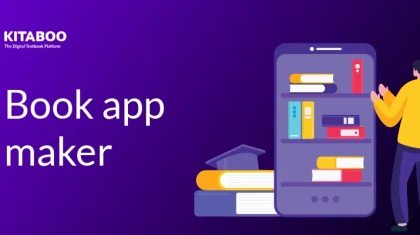
Types of Assessments: Online vs. Offline Assessments
Summarize this blog with your favorite AI:
In the realm of education and professional development, the advent of digital technology has ushered in a transformative era, redefining how knowledge is disseminated and assessed.
The traditional classroom setting, with its paper-based evaluations, is increasingly sharing space with the digital world’s dynamic, interactive platforms.
With the global online learning market growing 14% annually, educators are reassessing their teaching approach. Among their many concerns lies the dilemma of choosing between online or offline assessments. While online assessment has the advantage of convenience, offline assessment enables familiarity.
Digital textbook platforms, like KITABOO, are at the forefront of this educational revolution, aiding educators in striking the perfect balance between online and offline methodologies to yield the most effective outcomes.
In this post, we will explore the intricacies of online and offline assessments to help educators, students, and professionals understand the distinct characteristics and benefits of each.
Table of Contents:
I. The Fundamentals: Assessment vs Tests
II. Types of Offline Assessments
III. Types of Online Assessments
IV. Online vs Offline Assessments: Understanding the Differences
- Time and Resource Consumption
- Accessibility
- Record Keeping
- Environmental Impact
- Security
- Engagement and Interactivity
- Familiarity
V. Conclusion
The Fundamentals: Assessment vs Tests
When it comes to figuring out the best ways to evaluate learning, whether online or offline, it’s really important to get the difference between ‘assessments’ and ‘tests.’
While commonly used interchangeably, assessments and tests have key differences. Here is a quick overview of the same:
- Assessment is a broad concept involving information and evidence gathering. Its goal is to make calculated decisions.
- Testing is a relatively specific method within the vicinity of assessment. It focuses on measuring particular skills or attributes vis standardized tools.
- Assessment involves several factors, like observations, interviews, and even testing.
- Testing generally revolves around quantitative scoring or grading.
- Assessment is usually qualitative, while testing merely enables a narrow evaluation.
Types of Offline Assessments
Offline assessments are generally associated with standard education, using pen, paper, booklets, etc.
Let’s take a look at some of its most common types:
Paper-Based Exams
Paper-based exams have been at the core of education for centuries now. These exams are usually a part of high-stakes assessments.
Pros:
- Both educators and students are familiar with the format.
- Minimizes the chances of cheating or technical issues.
- No special equipment is needed for monitoring.
Cons:
- Consumes time in conducting and scoring
- Rigid format with limited interactivity
Performance Assessments
Performance assessments require students to apply their skills and learning in real-world situations. Some of its examples are art projects, oral presentations, and science experiments.
Pros:
- Offers a display of practical skills
- Facilitates creativity and active learning
Cons:
- Grading can be highly subjective
- Needs time and resources for evaluation
Types of Online Assessments
Unlike offline assessments, online assessments employ digital tools to analyze student learning. The approach boasts diversity, such as instructional assessment, and each method offers distinct pros and cons.
Here are some of its most common types:
Multiple-Choice Questions
MCQs are among the most popular assessment methods worldwide. The method requires students to select the right answer from several options.
Pros:
- Added convenience of automated scoring
- Saves time and resources in grading
- Difficulty can be adjusted based on the students
Cons:
- Offers limited assessment of cognitive skills
- Prone to the involvement of external parties or resources
Online Polls or Surveys
In the educational field, online surveys or polls have become one of the most popular ways to collect data. The method helps paint a general idea of student preferences and requirements.
Pros:
- Anonymity can enable an honest response
- Simple processing and interpretation
Cons:
- Limited use cases
- Hard to measure or quantify the results
Interactive Assessments
Facilitating enhanced student engagement with interactive assessment is a huge advantage of online assessment. These sessions involve virtual activities that can stimulate learners’ minds.
Pros:
- Highly engaging with active participation
- Facilitates real-time feedback
- Ideal for diverse learning and teaching styles
Cons:
- Prone to technical issues
- Requires technical equipment and expertise
Online vs Offline Assessments: Understanding the Differences
With a clear understanding of the distinct benefits offered by both online and offline assessment approaches, let’s now look at them side by side to figure out how they match up against each other.
Time and Resource Consumption
Online: With online assessments, it is simple to set up everything for several students. It requires less time and resources to conduct, grade, and assess.
Offline: These assessments are highly time and resource-consuming through and through.
Accessibility
Online: Despite the internet boom, online assessments are not accessible everywhere. They require compatible devices and internet access, which are still unavailable in rural areas.
Offline: These assessments are more accessible and can be conducted regardless of technological advancements.
Record Keeping
Online: Online assessments can be organized, recorded, and stored freely.
Offline: With offline assessments, there is an issue of storage space.
Environmental Impact
Online: Despite running on electrical devices, online assessments have a relatively lower impact on the environment.
Offline: Since offline assessments use paper, conducting them for numerous students can affect the environment.
Security
Online: Online assessments must use advanced security measures to prevent cheating. Even minor technical glitches can pose immense trouble in this case.
Offline: Offline assessments do not rely on such measures for security. Moreover, there is no scope for technical glitches in this approach.
Engagement and Interactivity
Online: This approach can employ multimedia elements and simulations to keep students engaged. With a digital textbook platform like KITABOO, such sessions can be elevated for boosted attention retention.
Offline: The rigidity of offline assessments makes them highly non-interactive and unengaging. The options for external assistance are also limited in this regard.
Familiarity
Online: Online assessments require technical know-how for execution. The approach is not as familiar as its alternative among students and educators.
Offline: Students and teachers are well-acquainted with offline assessments. Many students still find it easier to write with a pen than typing on a keyboard.
Conclusion
It is clear that there is no standout winner between online and offline assessments. While the former offers several advantages, it requires technical expertise and seamless execution for best results.
Contrarily, offline assessments offer better security but can be unengaging and costly. Thus, educators must strike a balance between the two for a blended approach. Digital textbook platforms like KITABOO are instrumental in this blend, providing rich, immersive content experiences powered by artificial intelligence.
It not only assists in crafting tailored educational journeys but also empowers institutions to publish, share, and promote their educational offerings on a global scale.
Connect with our experts for further details!
Write to us at contact@kitaboo.com for more details!
Suggested Reads:
- Offline Activity Tracking Now Possible With KITABOO
- Moodle Integration with KITABOO
- Best ePUB Readers for Android, Mac and Windows Devices
- How to Convert PDF to ePUB3 while Keeping the Format Intact?
- What Is Interactive Storytelling and Why It Is Important?
- Digital Textbook Platform for K12 Publishers
- Digital Textbook Platform for Associations & Societies
- Digital Textbook Platform for Trade Publishers
- Digital Textbook Platform for Training Companies
- Digital Publishing Solution for Content Aggregators
Discover how a mobile-first training platform can help your organization.
KITABOO is a cloud-based platform to create, deliver & track mobile-first interactive training content.



